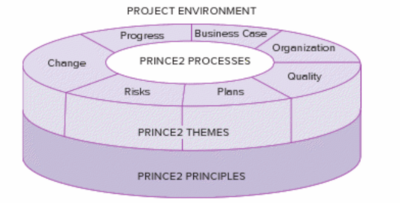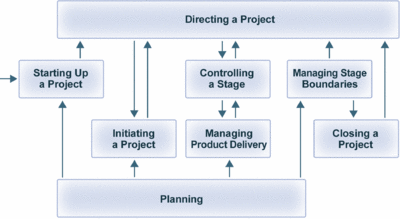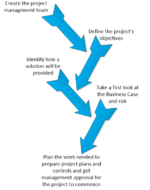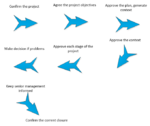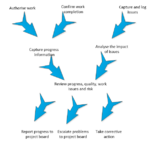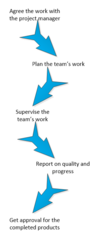PRINCE2, A Project Management Methodology
(→Overview of the method) |
(→Overview of the method) |
||
| Line 19: | Line 19: | ||
The processes are: Starting up a project (SU), Directing a project (DP), Initiating a project (IP), Managing stage boundaries (SB), Controlling a stage (CS), Managing product delivery (MP), Closing a project (CP) and Planning (PL), these are described in more details later in the article. | The processes are: Starting up a project (SU), Directing a project (DP), Initiating a project (IP), Managing stage boundaries (SB), Controlling a stage (CS), Managing product delivery (MP), Closing a project (CP) and Planning (PL), these are described in more details later in the article. | ||
| − | The themes are: | + | The themes are: Business case, organization, quality, plans, risk, change and progress, these are described in more details later in the article. |
| + | |||
| + | The last element in the PRINCE2 methodology is the project environment: | ||
= Overview of principles = | = Overview of principles = | ||
Revision as of 16:23, 13 September 2015
Project management is a discipline that is indispensable and rapidly expanding as an organization nationally and globally. To implement new strategies and products successfully, an organization needs to select project managers to introduce new products, services with a purpose of gaining competitiveness in the market. However by selecting a project manager and a team, an organization is not guaranteed successful project outcomes.
In past years different methodologies have been developed to help organizations consider all the necessary components of project management, e.g. planning, controlling, communication and finalization of projects. One of the widely used project management methodologies is the PRINCE2 method, this methodology is based on seven principles and seven themes which will be described throughout this article. While this article is going to be used publicly, it is important to know other properties of this methodology, e.g. scalability and advantages, in order to make the right discussion while choosing a project management methodology.
Contents |
PRINCE2
PRINCE (PRoject IN Controlled Environments) is a structured method for effective and efficient project management. The method was developed from an exiting method PROMPTII, which was developed by Simpact Systems Ltd in 1975. In 1979 PROMPTII was adopted by CCTA (The Central Computer and Telecommunications Agency) in UK as the standard for all government projects, mainly for IS (Information Systems) projects. In 1989 Superseded PRINCE the exiting method PROMPTII within government projects. [book]
CCTA continued developing the method and in 1996 launched PRINCE2 in response to user requirements for improved guidance on project management on all projects, not only IS projects. PRINCE2 is based on experiences of European project managements and project teams, who have contributed, some from their successes and others from their mistakes and omissions. [1]
Overview of the method
PRINCE2 is a process driven project management methodology. This method is based on four elements. The principles, the processes, the themes and the project environment, these elements are also shown on figure 1.
The principles are: Business justification, Learn from experience, Roles and responsibilities, Manage by stages, Manage by exception, Focus on products and Tailor to suit the environment, these are described in more details later in the article.
The processes are: Starting up a project (SU), Directing a project (DP), Initiating a project (IP), Managing stage boundaries (SB), Controlling a stage (CS), Managing product delivery (MP), Closing a project (CP) and Planning (PL), these are described in more details later in the article.
The themes are: Business case, organization, quality, plans, risk, change and progress, these are described in more details later in the article.
The last element in the PRINCE2 methodology is the project environment:
Overview of principles
The first integrated element of PRINCE2 is the principles. You can think of this element us a core concept that the rest of PRINCE2 method adheres to. The seven principles are described in details below.
Business justification
The continued business justification principle supports the need for an updated documentation and approved justification at the start and during the project.
Learn from experience
Every project is unique and this uniqueness leads to risk and challenges. The project team should learn from previous projects through log reviewing, in order to avoid the same mistakes.
Roles and responsibilities
Everyone working on a project should know the nature of their involvements, and what they are responsible for. A project should have defined and agreed roles and responsibilities within an organization.
Manage by stages
A PRINCE2 project is controlled, planned and monitored on stage by stage basis. Business case, risk and detailed plan for the next stage should be developed after the previous stages are completed and at the end of every stage the project board should assesses the performance.
Manage by exception
A PRINCE2 project should have defined tolerances for each project objectives and manage by exception is used in the project organization to manage the level below. The level below should only notify the upper level if there is a big issue that is outside their tolerance.
Focus on products
A PRINCE2 project focuses on the definition and delivery of products. Focus on products states that a product description should be written as soon as possible, so that the stakeholders will have a clear idea of what to expect.
Tailor to suit the environment
The PRINCE2 method can be tailored to all kind of projects no matter the size, environment, complexity and risk.
Overview of processes
The second integrated element of PRINCE2 is the eight Processes. See the PRINCE2 processes model, shown in Figure 2. All of these processes provide a set of activities showing how to manage different parts of the project. The processes cover activities from starting of a project, through controlling, planning and closing of the project. Each processes covers a specific task and time during the project, below the processes are described in detail.
Starting up a project (SU)
The first process within a PRINCE2 project is SU (Starting Up a project). There are two types of projects within an organization, a project that can standalone or a project which is a part of a program, in case of the last one, a program manager can start a project within his existing project team. In case of the first one, a project can only triggered by a program manager or by issuing a Project Mandate. This document will contain sufficient information about the project and why it is important for the organization, in order to start a project, a senior project manager or board of directors, should give approval to the project.
Developing a detailed plan for a project takes allot of resources, and as a first step SU can be used as a filter, filtering good projects from the bad, those bad projects that should not even be started in the first place. Figure 3. Starting up a project overview, shows the steps which should take place before starting a PRINCE2 project.
Some key points in SU process:
- Creating the project management team
- Define th project objectives
- Identify how a solution will be provided
- Take a first look at the business case and risk
- Plan the work needed and get the management approval to start the project.
Directing a project (DP)
The second process within a PRINCE2 project is DP (Directing a Project). This process is used by the project board to provide direction and authorization to the project at key points. This also enables the project board to be accountable for the project's success. The project board delegate day-to-day management of the project to the project manager, releasing the project to project manager one stage at a time. Figure 4, Directing a project overview shows, how the second process is formed and should be implemented.
Some key points in DP process:
- Confirm the project
- Agree the project objectives
- Approve the plan, generate context
- Approve the context
- Approve each stage of the project
- Make decision if problems
- Keep senior management informed
- Confirm the current closure
Initiating a project (IP)
The third process within a PRINCE2 project is IP (Initiating a Project). IP is mainly about project plan and setting up the rules (strategies) and establish solid foundation for the project. IP enables the organization to understand, that this project needs to be done.
Some key points in IP process:
- Prepare the risk management strategy
- Set up project controls
- Prepare the quality management strategy
- Create the project plan
- Refine the business case.
Managing stage boundaries (SB)
The fourth process within a PRINCE2 project is SB (Managing Stage Boundaries). This process ensures that the project is divided into manageable stages, so that the project board better can review the project progress. The purpose of SB for the project manager is to prepare the next stage of the project and provide relevant and accurate information to the project board, so that the decision for project continuation can be taken.
Some key points in SB process:
- Plan the next stage
- Update the project plan
- Update the business case
- Report stage end
- Produce an exception plan
Controlling a stage (CS)
The fifth process within a PRINCE2 project is CS (Controlling a Stage). This process describes the activities of the project manager, within each stage of the project, it also specifies the way in which progress should be monitored and how the highlights of the progress should be reported to the project board. A project manager should provide accurate information to the project board, so the correct actions can be taken. Figure 5, controlling a stage shows the steps in this process.
Some key points in CS process:
- Authorize a work package
- Review work package
- Review completed work package
- Review stage
- Report highlights
- Report Issues
- Risk management
- Take corrective action
Managing product delivery (MP)
The sixth process within a PRINCE2 project is MP (Managing Product Delivery). This process has the purpose of controlling the link between the project manager and the team manager(s), by placing the formal requirements on accepting, executing and delivering project work. The role of the team managers are to coordinate an area of work the deliver one or more of the products. Figure 5. Managing product delivery shows the work flow of this process.
Some key points for MP process:
- Agree on work with project manager
- Plan team's work
- Supervise
- Report quality
- Get approval of project board
Closing a project (CP)
The seventh process within a PRINCE2 project is CP (Closing a Project). This process covers the things that should be done at the end of a project. The project be formally de-commessioned and the resources should be reallocated to other projects. The project manager should make sure that the products are delivered and approved, and the team is prepared to deal with the unresolved issues and risks.
Some key points for CP process:
- Prepare planned closure
- Hand over products / results
- Evaluation
- Recommendation
Planning (PL)
The eighth process within a PRINCE2 project is PL (Planning). This process describes how to plan effectively. Every project relies in an effective planning and control process, even if the project is very small, it require planning. Planning process provides the project team with important information, for example, what is required, how it will be achieved and by whom and when, using what specialized equipment ect. In PL the technique of product-based planning is used, it is a comprehensive planning method that enables the project managers to control progress, it provides a description of product requirements, which skills needed, quality and other requirements in order to developed a product that is within the required tolerances.
Overview of themes
The third integrated element of PRINCE2 is the themes. The themes describe how PRINCE2 recommends to carry out various aspects of project management. For example, the risk themes recommends how to manage risk in a project. Each of the themes may be useful throughout all the processes described above in Overview of processes.
Business case
The business case theme describes how to ensure the project have a solid and justified reason to exist.
Organization
The organization theme defines the structure of the project team. It describes the various roles within the structure and sets out their responsibilities.
Quality
The quality theme describes how to ensure that the project products are fit for the purpose for which they will be used.
Plans
The plans theme describes how to plan and what products to create and what activities are needed to build the products.
Risk
The risk theme describes how to manage providential threats and opportunity in the project.
Change
The change theme describes how to manage change in the project.
Progress
The progress theme describes how to track progress in the project and how to manage it in order to keep the project on track.
The Benefits of PRINCE2
A good project management method will guide the project through a controlled, well-managed and visible sets of activities to archive organization goals. Organizations are aware of the benefits a project management method can bring, and some of the benefits are:
- A repeatable method
- A structured method
- Building on experience
- Ensuring that everyone knows what to expect, where, how and when
- Early warning of problems
Sometimes projects are related to each other or they are a part of a larger program an organization is managing, in all these situations the PRINCE2 method is applicable, it can provide the organization with:
- Active involvement of users and stakeholders in the project
- Controlled management of resources
- Controlled management of risks
- focused on goal of the project, what the project is delivering, why and by whom
PRINCE2 provide the project with:
- Organized start, middle and end of a project
- Regular reviews of the progress
- Good communication between project management team and organization
Project managers are able to:
- Keep meetings in the vital points of the project
- Provide brief reporting about the project
- Divide projects into manageable stages in order to make the goals achievable
